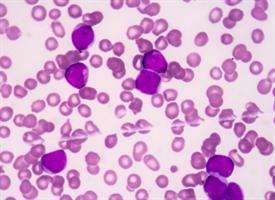Scientists aim at a genetically lethal strain of leukemia

Researchers at UR Medicine's Wilmot Cancer Institute have developed what they believe to be the first mouse model to investigate why a certain subset of acute myeloid leukemia (AML) patients responds particularly poorly to chemotherapy.
Approximately 15 percent of AML patients harbor a mutation in the RUNX1 gene, and in these patients, standard treatment is unable to eradicate leukemic cells from their bone marrow, where the cancer is rooted. Scientists do not fully understand the underlying mechanisms protecting these residual AML cells.
An article published Wednesday in the journal PLOS ONE by corresponding author Jason H. Mendler, M.D. Ph.D., suggests that a genetically defined mouse model of RUNX1-mutated AML, developed at Wilmot, is the ideal platform to investigate the cellular mechanisms protecting residual AML cells in this molecular subtype of the disease.
"Like all cancers, leukemia is not a one-size-fits-all, and therefore it's important to find better ways to study high-risk subtypes of the disease," said Mendler, an assistant professor of Oncology. "We believe our mouse model will allow us to quickly define new ways to target this challenging disease."
In fact, Mendler's laboratory has already begun a pre-clinical collaboration with a drug company that has a therapy to target a pathway found to be overactive in RUNX1-mutated AML cases. Successful therapeutic approaches within these models will be brought into clinical trials targeting RUNX1-mutated AML patients as soon as possible, he said.
Leukemia is a complex disease consisting of many molecular variations. Typically, 15 to 20 genes are recurrently mutated in AML patients, with different disease-causing constellations present in individual cases. Further complicating the matter, many AML patients appear to have normal chromosomes after an initial genetic analysis, but a deeper analysis finds mutations such as RUNX1, which carries a uniformly bad prognosis.
Mendler partnered with the Genomics Research Center at the University of Rochester Medical Center to uncover five other key mutations that co-exist with the RUNX1 mutation in their mouse model. Further investigations will be focused on identifying the interplay of genes and pathways critical to mediating chemotherapy resistance within this model.
More information: "Residual Disease in a Novel Xenograft Model of RUNX1-Mutated, Cytogenetically Normal Acute Myeloid Leukemia." PLoS ONE 10(7): e0132375. DOI: 10.1371/journal.pone.0132375















